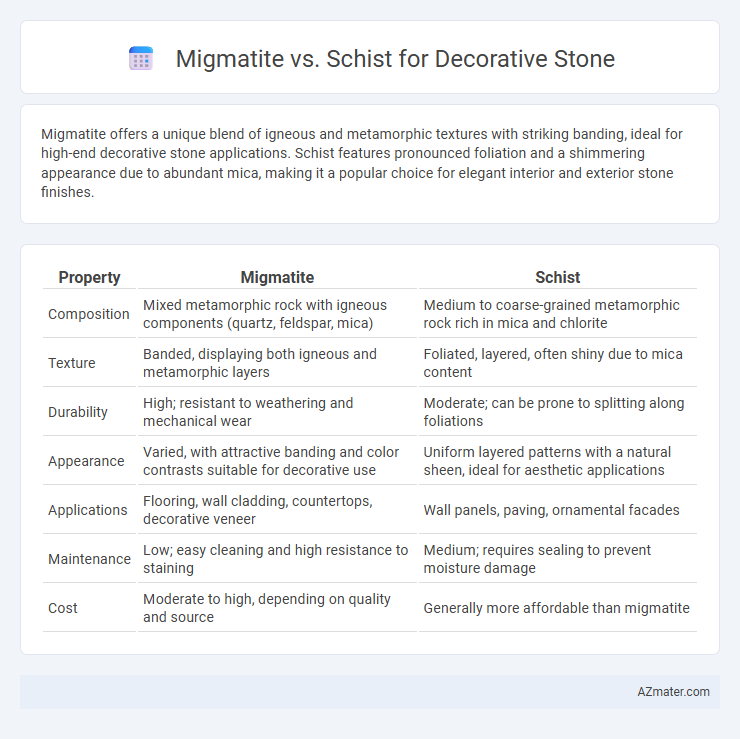Migmatite offers a unique blend of igneous and metamorphic textures with striking banding, ideal for high-end decorative stone applications. Schist features pronounced foliation and a shimmering appearance due to abundant mica, making it a popular choice for elegant interior and exterior stone finishes.
Table of Comparison
| Property | Migmatite | Schist |
|---|---|---|
| Composition | Mixed metamorphic rock with igneous components (quartz, feldspar, mica) | Medium to coarse-grained metamorphic rock rich in mica and chlorite |
| Texture | Banded, displaying both igneous and metamorphic layers | Foliated, layered, often shiny due to mica content |
| Durability | High; resistant to weathering and mechanical wear | Moderate; can be prone to splitting along foliations |
| Appearance | Varied, with attractive banding and color contrasts suitable for decorative use | Uniform layered patterns with a natural sheen, ideal for aesthetic applications |
| Applications | Flooring, wall cladding, countertops, decorative veneer | Wall panels, paving, ornamental facades |
| Maintenance | Low; easy cleaning and high resistance to staining | Medium; requires sealing to prevent moisture damage |
| Cost | Moderate to high, depending on quality and source | Generally more affordable than migmatite |
Introduction to Migmatite and Schist
Migmatite is a composite rock featuring both igneous and metamorphic characteristics, formed under extreme temperature conditions, displaying distinct light and dark bands ideal for unique decorative stone applications. Schist is a medium to coarse-grained metamorphic rock characterized by pronounced foliation and flaky minerals such as mica, favored for its textured appearance and durability in interior and exterior decor. Both rocks offer contrasting aesthetic qualities and structural properties, making them popular choices in architectural and design projects.
Geological Formation and Composition
Migmatite forms through partial melting and high-grade metamorphism, resulting in a mixed composition of igneous and metamorphic minerals, often exhibiting banded patterns with quartz, feldspar, and biotite. Schist develops under moderate to high-grade metamorphism, characterized by well-aligned mica minerals such as muscovite or biotite, giving it a foliated texture ideal for decorative applications. The contrasting formation processes influence their durability and aesthetic, with migmatite showing intricate patterns due to partial melting, while schist presents a consistent, layered look favored in ornamental stonework.
Visual Appearance: Patterns and Colors
Migmatite showcases intricate patterns with a striking blend of light and dark bands, creating a marbled effect ideal for decorative stone applications. Schist features foliated layers with a shimmering, flaky texture, often displaying silver, gray, or green hues that add visual depth and elegance. The contrasting patterns of migmatite bring dynamic visual interest, while schist offers a more uniform, yet richly textured appearance perfect for sophisticated design.
Durability and Weather Resistance
Migmatite exhibits greater durability and superior weather resistance compared to schist, due to its hybrid composition of metamorphic and igneous rock layers, providing enhanced structural integrity. Schist, characterized by its foliated texture and abundant mica content, tends to be more susceptible to weathering and surface erosion when exposed to outdoor elements. For decorative stone applications requiring long-term resilience and minimal maintenance, migmatite is often preferred for its robustness and ability to withstand harsh environmental conditions.
Workability and Ease of Shaping
Migmatite offers moderate workability with a unique blend of igneous and metamorphic textures, making it slightly harder to shape than schist due to its mixed mineral composition and foliation complexity. Schist, characterized by its pronounced foliation and softer mica-rich layers, is easier to cut and shape, providing greater ease in achieving intricate designs and smooth finishes for decorative stone applications. Both stones provide unique aesthetic qualities, but schist's superior workability often makes it the preferred choice for detailed ornamental work.
Cost Comparison and Market Availability
Migmatite generally commands a higher price than schist due to its rarity and complex formation process, making it less common in the decorative stone market. Schist is widely available and more affordable, often preferred for large-scale projects requiring consistent supply and budget efficiency. Market availability favors schist, with numerous quarries supplying diverse color variations, while migmatite is typically sourced from limited locations, driving up procurement costs.
Suitability for Interior Design
Migmatite offers a unique blend of igneous and metamorphic textures, providing a striking, marbled appearance ideal for statement walls and countertops in interior design. Schist's foliated structure and reflective mica minerals create a shimmering, textured surface suitable for accent pieces and decorative flooring. Both stones are durable, but migmatite's distinctive patterns lend a more dramatic aesthetic, while schist offers subtle elegance in decorative stone applications.
Outdoor Applications and Performance
Migmatite offers superior durability and resistance to weathering compared to schist, making it ideal for outdoor decorative stone applications such as patios and facades. Its interlayered composition of metamorphic and igneous materials provides enhanced structural stability and a unique, variegated appearance that resists fading and erosion. Schist, while visually appealing with its foliated texture, tends to be softer and more prone to delamination and surface wear when exposed to harsh outdoor environments.
Environmental Impact and Sustainability
Migmatite, composed of mixed metamorphic and igneous components, typically exhibits higher durability and longevity, reducing the need for frequent replacement and minimizing environmental impact over its lifecycle. Schist, characterized by its foliated structure and mineral composition, often involves less energy-intensive extraction but may require more maintenance or replacement, potentially increasing its environmental footprint. Both stones' sustainability hinges on responsible quarrying practices, with migmatite's robustness offering an edge in long-term eco-friendly applications for decorative stone.
Choosing Between Migmatite and Schist for Decorative Stone Projects
Migmatite offers a unique blend of igneous and metamorphic textures, providing intricate patterns and robust durability ideal for high-end decorative stone projects. Schist features pronounced foliation and a crystalline appearance, delivering elegance and a wide range of color options suitable for aesthetic-driven designs. Selecting between migmatite and schist depends on the desired visual complexity and structural strength required for the specific application.

Infographic: Migmatite vs Schist for Decorative Stone
 azmater.com
azmater.com